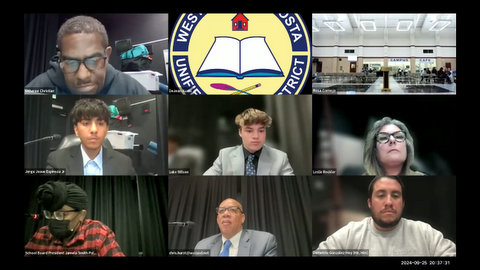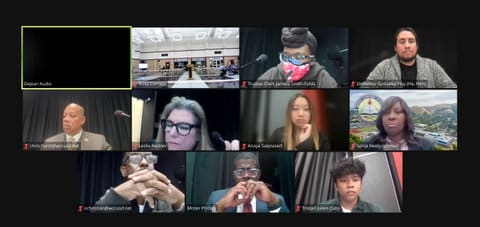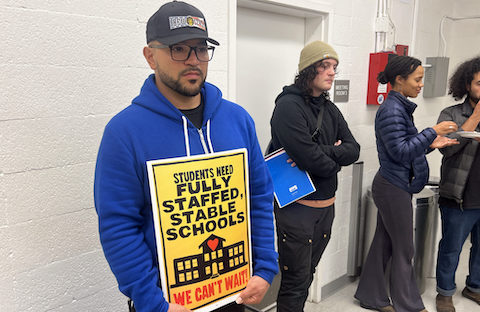
30 Sep WCCUSD Tries to Figure Out How It ‘Can Improve Those Numbers’

(Screenshot captured by Samantha Kennedy / The CC Pulse)
By Samantha Kennedy
The West Contra Costa school board at its Wednesday meeting voted to approve unaudited financials from the 2023-24 school year — including $6.6 million in unexpected revenues.
But the district’s ongoing struggles with financial stability — namely an over $20 million budget deficit over the next two years — won’t be fixed that easily.
The district says it’s pursuing other ways to increase revenue in its unrestricted balance, which is used to fund base programs in the district and teacher salaries.
“We’re looking really hard to build our programs,” said Kim Moses, the district’s associate superintendent of business services, “to keep our programs intact, so that we can attract more families.”
Moses says revenue for the district’s unrestricted fund can largely only be generated through enrollment and average daily attendance.
“We are constantly focused on that because we know that is a game changer in terms of how our multi-year projections look,” said Moses. “Under the direction of [Superintendent] Dr. Hurst and the cabinet, it is a concern and constant source of discussion on how we can improve those numbers.”
Following COVID-related school closures in 2020 that forced districts to turn to remote learning, California students were chronically absent at record highs in the 2021-22 school year. For the state, that was a chronic absenteeism percentage of about 30%. Nearly 40% of WCCUSD students were chronically absent that same year, but the percentage dropped to 32% the next year, according to state data.
Students are considered chronically absent when they are absent for 10% or more of the days they were enrolled.
WCCUSD, even before school closures in 2020, struggled with chronic absenteeism. Reports from the California attorney general between 2013 and 2016 show the then-30% chronic absenteeism percentage as one of the highest in the Bay Area.
The board approved the financials with Trustee Mister Phillips absent. Independent auditors must also approve the statements.
Moving forward with policies in suicide prevention, menstrual equity
Following discussions at the Sept. 25 meeting, the board is expected to adopt policies related to suicide prevention and menstruation equity in the district.
Discussions for the policies come after a revised state law expanded menstrual access for students and after statistics showed almost 1 in 5 teens have considered suicide.
Gov. Gavin Newsom last year approved changes to AB 230, known as the Menstrual Equity Act for All, requiring menstrual products be provided in bathrooms used by students in third to 12th grade. The products must be stocked in every all-gender and women’s restroom and at least in one men’s restroom.
“The District also recognizes that people of different gender identities menstruate, including cisgender girls, transgender boys and men, nonbinary people, and gender-nonconforming people,” the proposed menstrual equity policy reads. “The District has an interest in promoting gender equity and creating a supportive and inclusive learning environment.”
In addition to requirements under state law, Board President Jamela Smith-Folds and Trustee Leslie Reckler encouraged that the size and quality of the menstrual products be taken into consideration.
“It’s a safety issue just like it’s a humanitarian issue, just like it’s a health issue,” said Smith-Folds. “So when we are putting things near, on or around our bodies, they need to be as safe as possible.”
The policy also requires each school site have the contact information for whoever is responsible for restocking the products in each restroom. District staff have discussed expanding on this, according to clerk Demetrio Gonzalez-Hoy, who said some students may not be comfortable reaching out to the assigned contact and would prefer to reach out to another trusted adult at the school.
While the board’s menstrual policy could be sent back to the governance committee for revisions, the revised suicide prevention policy could be back for adoption as soon as the next meeting.
The revisions clarify staff training guidelines and outline a tiered approach to addressing suicide in students.
Last year, a California Healthy Kids Survey showed that almost 40% of 11th graders in the district felt “chronic sadness.” In that same survey, almost 20% of ninth graders reported considering suicide.
>>>Read: WCCUSD to Try to Increase Mental Health Support Despite Shortages<<<
“The possibility of suicide and suicidal ideation requires vigilant attention from our school staff,” part of the policy reads. “As a result, we are ethically and legally responsible for providing an appropriate and timely response in preventing suicidal ideation, attempts, and deaths.”
Following the survey results, the board partnered with Care Solace, which helps students in the district access mental health care.
>>>From Our Archives: As Pandemic Worsens Students’ Mental Health, WCCUSD Tries to Keep Up<<<
“As a district, we believe the physical and emotional safety of our students is critical,” said Summerlynn Sigler, the district’s associate superintendent of K-12 operations, at Wednesday’s meeting.
The next West Contra Costa school board meeting is Oct. 8.






No Comments